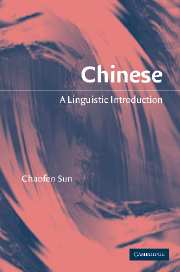Book contents
- Frontmatter
- Contents
- List of maps
- List of tables
- List of figures
- Preface
- Major chronological divisions of Chinese history
- Major periods of the Chinese language
- Introduction
- 1 Historical background of the language
- 2 Phonetics of standard Chinese
- 3 Chinese morphology 1
- 4 Chinese morphology 2
- 5 Chinese writing
- 6 Chinese language and culture
- 7 Chinese syntax 1
- 8 Chinese syntax 2
- Appendix 1 Phonetic symbols
- Appendix 2 Capitalized abbreviations
- References
- Index
- References
References
Published online by Cambridge University Press: 05 September 2012
- Frontmatter
- Contents
- List of maps
- List of tables
- List of figures
- Preface
- Major chronological divisions of Chinese history
- Major periods of the Chinese language
- Introduction
- 1 Historical background of the language
- 2 Phonetics of standard Chinese
- 3 Chinese morphology 1
- 4 Chinese morphology 2
- 5 Chinese writing
- 6 Chinese language and culture
- 7 Chinese syntax 1
- 8 Chinese syntax 2
- Appendix 1 Phonetic symbols
- Appendix 2 Capitalized abbreviations
- References
- Index
- References
- Type
- Chapter
- Information
- ChineseA Linguistic Introduction, pp. 225 - 228Publisher: Cambridge University PressPrint publication year: 2006



